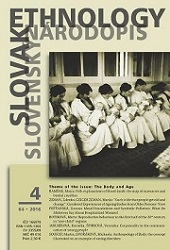Reproductive behaviour in the first half of the 20th century in “one-child” regions
Reproductive behaviour in the first half of the 20th century in “one-child” regions
Author(s): Marta BotíkováSubject(s): Anthropology, Gender Studies, Customs / Folklore, Gender history, Cultural Anthropology / Ethnology, Culture and social structure , Demography and human biology
Published by: Ústav etnológie a sociálnej antropológie Slovenskej akadémie vied
Keywords: demographics; Slovakia; Hungary; reproductive behaviour; single-child system;
Summary/Abstract: Historical and demographic literature saw the issue of birth control in Hungary in the early decades of the 19th century. Ethnological research processes information on the phenomenon in general (Filová, 1975) and in some specific cultural expressions (Botíková, 1997). By carrying out repeated investigations we have obtained materialof biographical narratives, which present a more detailed context of a partnership, pregnancy, childbirth, care for the woman and child in the family in the villages, which for decades continuously (statistically) recorded birth control. We expect the single-child system is manifested in several aspects of life. The analysis is going to help in understanding the causes and functioning of this phenomenon.
Journal: Slovenský národopis
- Issue Year: 64/2016
- Issue No: 4
- Page Range: 486-499
- Page Count: 14
- Language: English

